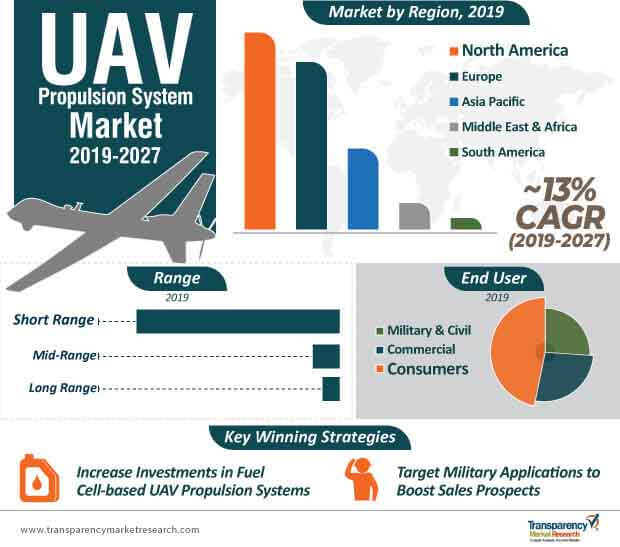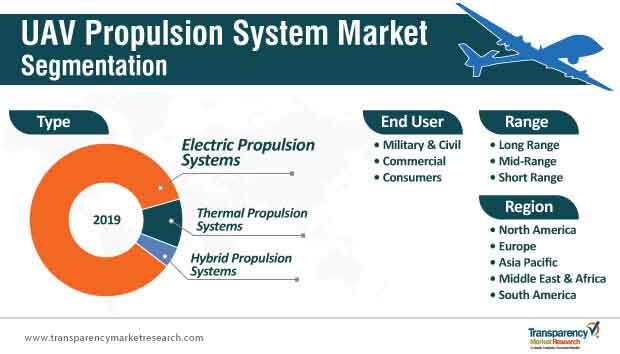
Unmanned aerial vehicle (UAV) propulsion systems are witnessing commercial applications beyond their traditional relevance in the military and defense sector, and are likely to draw volume sales tantamount to ~5.8 Bn units by the end of 2027. According to a recently published report by Transparency Market Research (TMR), UAVs have recently captured a lot of interest with the rise in cold wars and trade wars among various countries, and are deemed indispensable for the armed forces. A large number of developed countries have already embraced this modern surveillance system; however, with the current environmental scenario, strategic incentives are directed towards the development of propulsion systems that are propelled by fossil fuels and not combustion engines.
The potential use of drones in the packaging industry to facilitate the same-day delivery of goods is likely to widen the clientele base for UAVs, thereby fortifying opportunities for manufacturers. However, manufacturers have been expending efforts towards controlling the development costs of propulsion systems, which otherwise directly gets added on to the product cost.

Request a sample to get extensive insights into the UAV Propulsion System Market
Fuel Cells – The Next Frontier in the UAV Propulsion System Landscape
With environmental concerns being at the front-of-the-mind focus, market players are taking propulsion approaches other than extant combustion engines, which is driving the shift towards the development of fuel cell and solar power. Fuel cells are gaining high traction as a viable alternative to small internal combustion engines, given their low heat and noise profile.
With increasing research and development activities, fuel cell-based UAV propulsion systems will allow better mission time and longer range as compared to other propulsion systems, which has been established as the key manufacturing trend in the UAV propulsion system market. For instance, a key market player, Protonex PEM, announced the launch of UAV fuel cell propulsion systems that offer 100% throttle flexibility, along with mid-air start-stop capability.
Besides this, market players are rethinking the designs of these propulsion systems for the development of fuel-efficient, lightweight, and high payload capacity systems, to set products apart and reap better sales opportunities.
To understand how our report can bring difference to your business strategy, Ask for a brochure
Electric Propulsion System to Remain Standard
As currently envisioned by the TMR study, electric propulsion systems will account for ~85% market share by 2027, followed by thermal propulsion systems; however, the adoption of hybrid propulsion systems will witness an exponential rise. Electrical propulsion systems shrink carbon footprint with lesser emissions, and are hence, making it to the top-selling UAV propulsion system category. However, the operating regulations of UAVs in different countries vary, which implies that, market players need to study regional protocols well before venturing into a new market.
Read TMR Research Methodology at: https://www.transparencymarketresearch.com/methodology.html
The report also shows the sustained lead of North America in the UAV propulsion system market during the forecast period, given the region’s generous investments in the military and defense sector. However, promising growth of consumer goods industry and demand for drone-based delivery services are likely to augur well for the Asia Pacific market during the forecast period.

Read Our Latest Press Release:
- https://www.prnewswire.com/news-releases/affordability-and-beneficial-properties-to-serve-as-vital-growth-factors-for-construction-tape-market-during-forecast-period-of-2020-2030-tmr-301221294.html
- https://www.prnewswire.com/news-releases/global-higher-education-solutions-market-to-thrive-on-growing-popularity-of-cloud-computing-and-high-consumption-of-digital-content-tmr-301219732.html





